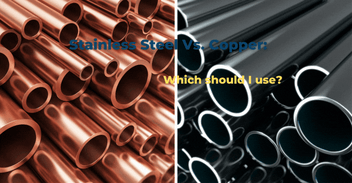What pipe material should you use for cleaning chemicals?
In a hygienic environment such as a food or pharmaceutical production facility, cleaning plays an important part in the day-to-day operations. While different plants have different processes and standards that apply depending on what a plant may be producing, the one thing they all have in common, which is critical to their trading ability and maintaining a strong brand reputation, is maintaining a high hygiene standard.
If you are considering a new cleaning system, I have no doubt there will be a lot of questions to answer. In this blog, we will narrow in and focus on one particular critical component, particularly to centralised cleaning systems…the pipework. A common question we get here is, what is the best pipe material for cleaning chemicals?
Common types of cleaning systems
Centralised Cleaning System
In larger production or processing plants it is common to find a centralised cleaning system. In a centralised system, chemicals are stored in a central location and pumped around the site through pipework to what are commonly known as satellite stations. Cleaning staff can connect to a satellite station and use the cleaning agents and sanitisers to clean the production or processing areas. Often found in larger plants, a centralised system can improve safety, particularly in the transportation and distribution of the chemicals, and improve efficiency in the cleaning process. On the other hand, a centralised system is a fixed system so if there is a change in the layout of the plant this may mean the system needs to be relocated, involving re-piping.
Decentralised Cleaning System
In smaller production or processing sites, and sometimes not so small, you may find a mobile cleaning system or what some may call a de-centralised system. This is essentially where staff transport chemicals around the site on a trolley. The cleaning chemicals are mixed with water inside the production or processing areas where the cleaning takes place. Being mobile these systems give a certain amount of flexibility for an operator to move where the cleaning is needed. They are also typically a cheaper option but can have a higher safety risk.
When selecting the best system for your site, we strongly recommend speaking with your chemical provider or an industry expert to get good advice on what system is best for your specific site.
What piping material should you choose?
Before we start, we appreciate there are a lot of opinions and experiences on what piping materials are best. We will share some observations from working with many food and beverage processing plants throughout New Zealand. Our comments here will be generalised as every project has different factors which need to be considered individually.
There are four primary pipe services we see in a centralised cleaning system.
- Water supply
- Compressed air
- Foaming agent
- Sanitiser
Ideally, these services are primarily installed in a roof space in a ring main with droppers strategically located above the production or processing areas, which penetrate through the ceiling and connect these services to the satellite stations located in the hygiene zones. It is normally agreed, that once the pipework enters the hygiene zone, stainless steel is the preferred piping material and this seems to work successfully in most plants. In some instances, a plant may opt to run a larger stainless steel conduit dropper with multiple services inside. In this case, sometimes other piping materials may be used inside the conduit.
Being located in a roof space creates other factors that need consideration when selecting your preferred piping material. A roof space can have significant temperature extremes, both very hot and very cold which can have a major impact on pipework particularly in the way of thermal expansion and contraction. This is particularly the case with plastic piping systems.
Let’s take a look at each of the four services mentioned above.
Water Supply
Generally speaking, the water supply for cleaning systems utilises hot water. Exact temperatures will vary across different plants, as some run their systems over 90°C to counter heat loss from uninsulated pipework to ensure the water temperature is at 82°C at the point of discharge. Others have well-insulated pipework and therefore can run their systems at a lower temperature as heat loss is minimised. Given the temperatures, plastic piping systems do have limitations and particular caution must be paid to pressure derating relative to the increase in temperature. Situations have arisen where internal erosion in the pipework, due to both elevated temperature and flow velocity through the pipe system has eventually led to “pin-holing” and pipe failure.
-
Stainless steel pipework
It is generally accepted that stainless steel pipework is a good option for water supply services. In the roof space, some plants opt to use 304L grade stainless steel and switch to 316L for the droppers into the hygiene zones. Others prefer to go with 316L for the complete system. 304L offers some capital savings over 316L, however 316L does have higher corrosion resistance. Mostly, plants are opting to go for 316L for the complete system.
Given the likelihood of elevated operating temperatures, if using a stainless steel press-fit piping system, such as Europress, the use of the green FKM high-temperature O-Ring seals is recommended. Several plants are standardising these seals for all applications to eliminate the possibility of incompatible seals being installed.
Compressed Air
Again, there are various piping materials you can opt for here, but most commonly production plants are standardising on 316L stainless steel for compressed air. There are some plastic options available, such as HDPE, however, you must ensure you are installing compressed air approved materials. PVC is not suitable for compressed air. Also, keep in mind that PE pipe in general, has a high susceptibility to thermal expansion and contraction, so being in a roof space where there can be significant temperature fluctuations, it is important to ensure you allow for thermal expansion and contraction and ensure you have bracketing requirements installed correctly.
Foaming Chemicals
This is arguably the application with the most factors to consider and where there is a wide range of opinions on what is the best piping system.
-
316L Stainless steel
Foaming chemicals often contain chlorine and/or chlorides at varying levels of concentrations. The term chloride refers either to a chloride ion, which is a negatively charged chlorine atom, or a non-charged chlorine atom covalently bonded to the rest of the molecule by a single bond. Many inorganic chlorides are salts. Chloride salts such as sodium chloride are often soluble in water. Therefore, it is important to assess what the chlorine content is in the chemical and select a piping system best suited.
Another factor to bear in mind, again given the pipework is largely in the roof space, when at high temperatures the chlorine can “flash off” which can be particularly harmful to stainless steel. This can especially happen when the chemical is sitting stagnant in the pipeline. High concentrations of chlorine combined with stainless steel is not recommended.
In saying this, 316L can handle very low concentrations of chlorine (typically as a rule of thumb we suggest lower than 300ppm). So again, depending on your concentration level it may be ok, but ensure you have thoroughly researched this.
-
PVC
Another option is PVC, most commonly either European-sized metric PVC or Sch. 80 PVC are used. There are varying opinions about which is best, however, the reality is, that both are suitable. In saying this, keep in mind, that PVC is susceptible to thermal expansion and contraction, so it is imperative you follow best practice design, particularly around bracketing, installation, and selecting the correct solvent cements.
Some in the industry claim they have issues with PVC splitting particularly on 90° elbows or tee’s. For this reason the use of long radius 90° bends and wye junctions can be beneficial. Often these issues can be caused by inadequate allowance for expansion and contraction, incorrect bracketing design, or incorrect installation processes. Also, keep in mind, that PVC is not UV resistant so if you are installing outdoors you will need to consider UV protection.
-
PE
In some instances, the use of Polyethylene pipe has been opted for. This may be the preferred option especially where there is a significant amount of pipework outdoors, due to the excellent UV resistance properties. There is a particular grade of HDPE known as CRP 100 RCD, which is a black resin renowned for its enhanced resistance to chlorinated disinfectants compared to conventional PE pipe. Particular attention must be given to the expansion and contraction of this pipe system and the installation of suitable compensating methods.
Sanitisers
In general pipe systems for Sanitiser chemicals is similar to ‘foaming chemicals’. It is critical to thoroughly research the composition of a sanitising chemical and this will determine the best piping material. Different manufacturers will have different compositions. It will also be important to consider other factors such as temperature when looking at these options.
Overall
As you will see, there are a number of factors that need to be considered as there isn't a ‘one-size-fits-all’ option. It is important to do thorough research and consider all factors before deciding on what piping system is best for you. Our Technical Sales team is here to help you select the best materials for your application.
Get advise from our sales team!

-1.png)


.png?width=352&name=Copy%20of%20WW%20%20Blog%20headers%202023%20(23).png)
.png?width=352&name=Waterworks%20%20Europress%20compressed%20air%20email%20graphic%20(1).png)